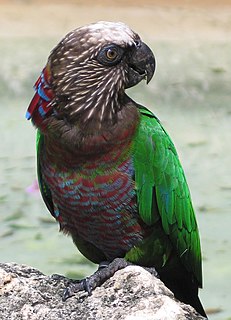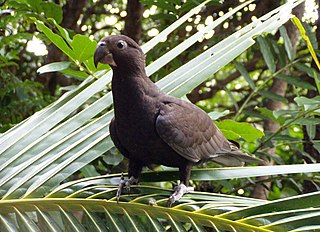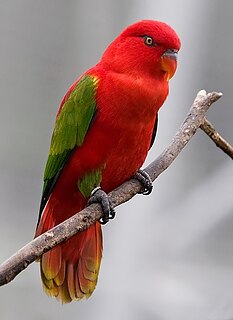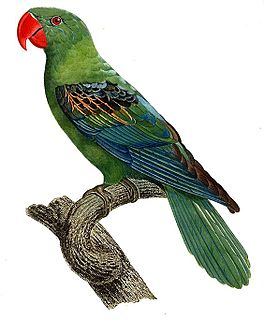
True thrushes are medium-sized mostly insectivorous or omnivorous birds in the genus Turdus of the wider thrush family, Turdidae. The genus name Turdus is Latin for "thrush". The term "thrush" is used for many other birds of the family Turdidae as well as for a number of species belonging to several other families.

Coracias is a genus of the rollers, an Old World family of near passerine birds related to the kingfishers and bee-eaters. They share the colourful appearance of those groups, blues and browns predominating. The two outer front toes are connected, but not the inner one.

Members of the parrot genus Psittacula or Afro-Asian ring-necked parrots they are commonly known in aviculture originate from Africa to South-East Asia. It is a widespread group with a clear concentration of species in south Asia, but also with representatives in Africa and the islands of the Indian Ocean. This is the only genus of Parrot which has the majority of its species in continental Asia. Of all the extant species only Psittacula calthropae, Psittacula caniceps and Psittacula echo do not have a representative subspecies in any part of mainland continental Asia. The rose-ringed parakeet, Psittacula krameri, is one of the most widely distributed of all parrots.

The red-fan parrot, also known as the hawk-headed parrot, is a New World parrot hailing from the Amazon Rainforest. It is the only member of the genus Deroptyus.

The white tern or common white tern is a small seabird found across the tropical oceans of the world. It is sometimes known as the fairy tern although this name is potentially confusing as it is also the common name of Sternula nereis. Other names for the species include angel tern and white noddy in English, and manu-o-Kū in Hawaiian. The little white tern, previously considered a subspecies of the white tern, is now recognised as a separate species.

The greater vasa parrot is one of two species of vasa parrot, the other being the lesser vasa parrot C. nigra. The greater vasa parrot can be found throughout Madagascar and the Comoros.

The vasa parrots (Coracopsis) are four species of parrot which are endemic to Madagascar and other islands in the western Indian Ocean. Some taxonomists formerly placed the genus in Mascarinus, but this is now thought to be based on the results of a heavily flawed, later-debunked genetic study.

The Seychelles black parrot, Praslin parrot or kato nwar is a sombre-coloured, medium-sized parrot endemic to the Seychelles. Historically, it has been treated as a subspecies of the lesser vasa parrot, although it shows morphological, ecological and behavioural differences. Recent phylogenetic research indicates that the Seychelles population has a long history of isolation and may be sister to the rest of Coracopsis. It is the national bird of the Seychelles.

The Seychelles parakeet or Seychelles Island parrot is an extinct species of parrot that was endemic to the Seychelles in the Indian Ocean. It was scientifically named Palaeornis wardi by the British ornithologist Edward Newton in 1867, and the specific name honours the British civil commissioner Swinburne Ward who procured the specimens that formed the basis for the description. It was found on the islands of Mahé, Silhouette, and possibly Praslin. Ten skin specimens exist today, but no skeletons. Though it was later moved to the genus Psittacula, genetic studies have led some researchers to suggest it should belong in a reinstated Palaeornis along with the closely related Alexandrine parakeet of Asia.

The Mascarene parrot or mascarin is an extinct species of parrot that was endemic to the Mascarene island of Réunion in the western Indian Ocean. The taxonomic relationships of this species have been subject to debate; it has historically been grouped with either the Psittaculini parrots or the vasa parrots, with the latest genetic study favouring the former group.

The chattering lory is a forest-dwelling parrot endemic to North Maluku, Indonesia. It is considered vulnerable, the main threat being from trapping for the cage-bird trade.

The purple-naped lory is a species of parrot in the family Psittaculidae. It is forest-dwelling endemic to the islands of Seram, Ambon, and perhaps also Haruku and Saparua, South Maluku, Indonesia. It is considered endangered, the main threat being from trapping for the cage-bird trade.

The brown-throated parakeet, also known as the Prikichi, St. Thomas conure or the brown-throated conure, in aviculture, is a species of parrot in the family Psittacidae.

The red lory is a species of parrot in the family Psittaculidae. It is the second-most commonly kept lory in captivity, after the rainbow lorikeet.

The red-billed parrot also known as coral-billed pionus or red-billed pionus is a species of parrot in the family Psittacidae. It is found in humid subtropical forests in the Venezuelan Coastal Range, Sierra Nevada de Santa Marta, and in the Andes from Colombia in north to Bolivia in south. Uniquely for a member of the genus Pionus, its bill is almost entirely bright red. The plumage is greenish with a dull blue chest and red undertail coverts.

Hypsipetes is a genus of bulbuls, songbirds in the family Pycnonotidae. Most of its species occur in tropical forests around the Indian Ocean. But while the genus is quite diverse in the Madagascar region at the western end of its range it does not reach the African mainland.

Tanygnathus is a genus of parrots in the Psittaculini tribe, of the superfamily of Psittacoidea.
In the 10th edition of Systema Naturae, published in 1758, the Swedish naturalist Carl Linnaeus described 554 species of bird and gave each a binomial name.

Psittrichasiidae is a family of birds belonging to the superfamily of the true parrots (Psittacoidea). It is a very small family, the smallest of the three families of the true parrots. It is divided into two subfamilies: Psittrichasinae and Coracopsinae, that contain a single genus each. The first contains a single species, native to New Guinea, and the second contains four living species distributed throughout Madagascar and other islands of the Indian Ocean.
The Comoros black parrot is a medium-sized parrot endemic to the Comoros. Historically, it has been treated as a subspecies of the lesser vasa parrot, although it shows morphological, ecological and behavioural differences. It was split as a distinct species by the IOC in 2021.




















